Psoriasis refers to of dermatitis and is manifested by skin rash unpleasant on the body. They are almost not evil, but highly itchy and unsightly seem, therefore, to engage in a man is a lot of disadvantages. Consider, what are the types of psoriasis, they differ and how you can cure the disease .
The classification of psoriasis of the ICD-10
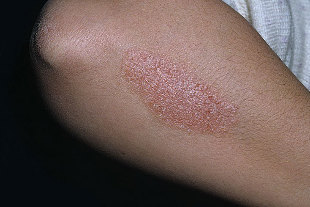
Of the international classification of diseases psoriasis given a code number L40. This means that it applies to papuloscentus violations of frigidity. papula - "backpack" and squama - "scales").
L40.0 Psoriasis vulgaris
Other names: plate-like. Diagnosed nearly 90% of the cases. Is manifested by papules scaly structure. The plates may be gray, gray-white or pink in color. The papules sometimes, multiply, bind with neighbouring countries and form in "islands" or "the lake".
L40.1 pustular Psoriasis generalized
Other names: pericardial, of impetigo, the disease Tsumbush. Considered the most severe, is manifested by bubbles or blisters, filled inflammatory substance - exudate. If the bubble is to reveal, and to the interior of the tomb of the infection, the psoriasis acquires purulent. Most often, these blisters occur on the hands and feet, more rarely on the body.
L40.2 Acrodermatitis resistant
Other names: dermatitis Crocker, dermatitis Settona. The contents of pustules (pustules), as a result of such form of psoriasis, sterile, therefore acrodermatitis is not contagious. The main drawback is that the plates may form on the fingers, because it can flake off the nails.
L40.3 Pustules of the palms and soles
Other names: pustular bactericidal. On the title it is understood that this type of psoriasis affects the feet and the palm. They are covered by the large and small pustular formations, which gradually multiply and increase the place. The contents of pustules sterile, pustular bactericidal is considered a serious disease. The treatment is complicated by the fact that the pustules are constantly subjected to mechanical stress (sand and burst, when walking).
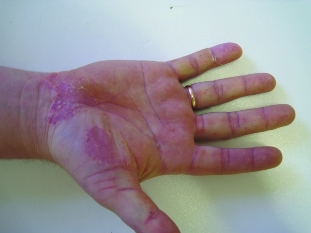
L40.4 Psoriasis normand
Is manifested by small dots, purple, scattered on the hips, the legs of the user, forearms , shoulders, head, neck and back. Often develops after the transfer of the strep throat or pharyngitis .
L40.5-7 Psoriasis arthropathic
Other names: arthropathy, psoriatic, arthritis psoriatic. The disease affects approximately 10% of all patients with psoriasis. Affects the joints and connective tissue . Externally manifested by the swelling of the phalanges of the hands and feet. Less likely to hit the hip, humeroscapular, the knee joints and the spine. Sometimes leads to disability: the patient can not move.
L40.8 Other psoriasis
Other names: psoriasis reversed. Manifest smooth inflamed patches that flake and are located in the skin folds and on the folds (in the groin, on the elbows, on the vulva, under breasts, etc). The difficulties of treatment of the other, psoriasis are associated with the continuous friction of affected areas, as well as the sweating in the creases of the skin. Often, the psoriasis inversé is the cause of the fungal infection.
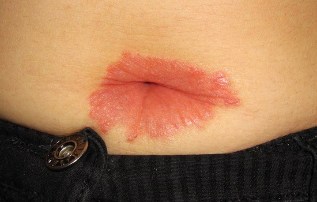
L40.9 Psoriasis unspecified
This includes all the other forms of psoriasis, which do not correspond to a above.
There is another division of the psoriasis in the clinical category and classification.
On the location of
Psoriatic plaques can spread to different parts of the body.
- The palms and soles. As it has already been stated above, it is pustular bactericidal (code L40.3).
- The joints . On psoriatic arthritis have also told (by code L40.5-7).
- The mucous membranes. The eruption manifests itself in the oral cavity, on the conjunctiva and mucous membranes of the genitals. Education in the form of inflammatory cells in different forms, but with clear boundaries. Around the small swelling.
- Nails . Scientific name: psoriatic onychodystrophy. Symptoms: deepening and grooves on the surface of the nail, matte nail plate, the peeling, the collapse of the, projection of the capillaries, itchy skin near the cuticle.
- Volosistaja a head part. This type is called seborrheic psoriasis. A lot of people confuse with dandruff , because one of the symptoms is the flaking of the skin of the head. But seborrheic psoriasis is much more unpleasant than the disease, because the skin splits also in the area of the auricles and may extend to the neck. All this is accompanied by the more strong itching, and bruising at the extraction scab .
- The large folds of the skin or intertrigio psoriasis. Plates formed between the fingers, in the groin, the armpits, under the breasts in women.
- The surface of the body. This phenomenon is called erythroderma. A variant of this disease has a high death rate , because, because of the defeat of the plates, the skin loses its basic functions: the regulation of the temperature, the protective barrier, etc
- The system of the defeat is too dangerous, because it involves the combination of several types of psoriasis.
According to the clinical picture
On the manifestations of psoriasis is:
- ordinary (vulgar);
- wet;
- pustular;
- arthropathic;
- in the form of a dermatitis.
Psoriatic erythroderma
Any typology is discussed above.
The development phase
If one considers the psoriasis from the point of view of staging , we can distinguish several steps.
Progressing psoriasis
The phase of maturation of the inflammation. Has of the following signs:
- education is pinkish smooth papules;
- itching;
- the inflammatory reaction after irritation of papules (scratching, the attempts to pierce it with a needle or a toothpick, etc);
- the beginning of peeling of the individual elements.
Fixed psoriasis
The stage runs almost without changes:
- new papules are not formed;
- the old plates is not an increase in the size;
- the desquamation moderate.
Retrogressive psoriasis
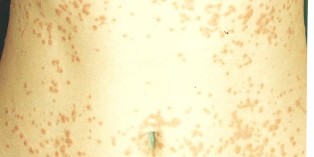
The last step, when the injuries are. The healing begins in the middle. The location of the former plate is formed of white depigmented patch, which does discomfort, aesthetics.
By the seasonality of the aggravation
For psoriasis is characterized by the season of relapse. In this regard, we distinguish:
- years, psoriasis: intensifies under the action of the rays of the sun;
- winter psoriasis develops due to the cold that affects the skin;
- off-season psoriasis: more than a severe form with absence of periods of remission. That is to say, the disease is throughout the year.
It looks like a manifestation of psoriasis in the form
On the site of the lesion of the skin
In this classification, only 2 type of psoriasis:
- limited to less than 20% of the skin of the body;
- common of more than 20%;
- universal - hit all the piderme.
The classification of the National fund (UNITED states)
Psoriasis varies and the place of the defeat:
- easy: defeat up to 2 % of the surface of the skin;
- average: from 2% to 10%;
- heavy: more than 10%.
International index PASI
The table for the calculation of the index lesions of psoriasis
The index PASI seems to be a number from 0 to 72 and means the degree of severity of the leak psoriasis of the lowest of the clinical signs ( erythema and flaking) to severe (bruising, suppuration). The index is determined by the specialists.
The treatment of psoriasis
The current treatment strategies of the disease include the application of a set of methods. It is important to respect the three main objectives:
- to quickly reach the primary positive results;
- tracking the ineffectiveness of certain methods and to cancel them, but to continue to use this helps;
- remove the patient from the remission.
Among the types of psoriasis treatment, we can distinguish two:
- not to the drug;
- drugs.
Non-drug treatment
If there is the possibility to happen of medicines, the doctors are still trying to use it. In the treatment of psoriasis a vital role may play several non-pharmacological factors of the therapy.Mode of action
People suffering from psoriasis, should:
- try to stop smoking;
- exclude alcohol (even beer);
- wear clothes and sleep on the under-clothes only from natural fabrics;
- change of laundry soap ;
- short cut nails;
- wash only in the shower, do not visit a steam room and a sauna;
- try to eliminate the stress.
The diet of psoriasis
On a positive dynamic in the treatment of psoriasis influence a low-protein diet to limit protein to 30 grams per day. Good results indicate that patients, once a week to do the unloading. On this day, you can eat 2-3 of tomato, a few leaves of lettuce, 1 cucumber, 2 to 3 cups of green tea and 300 ml unsweetened soda.
General principles of diet in psoriasis involve:
- of citrus juices;
- fresh or steamed vegetables;
- unsalted, of fish;
- pastries only-rye flour;
- dry fruits, fruits;
- nuts (50 g per day).
It is also appropriate to limit or exclude: meat, cereals, meat, sugar, potatoes, cheese, beans, oil, candy, coffee.
Spa therapy
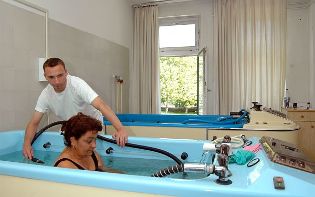
Spa therapy is taken away from the last place in the treatment of psoriasis. This is an excellent - the relapse factor.
Treat psoriasis can also be on the Dead sea .The main advantage of balneotherapy: the power of nature in the fight against the disease. The treatment of water, eating a balanced diet, fresh air and soft sunlight, it will reduce the symptoms of psoriasis and out of remission.
A variant of balneotherapy when the varicose veins is the treatment of Garra Rufa fish . These small creatures do not have teeth, but its lips they gently eat up, the particles of the scaly skin and improve the microcirculation of the outer skin. In addition, the procedure gives an excellent relaxing effect.
Physiotherapy
Among the methods of physiotherapy in the fight against psoriasis of the skin are the following:
- the ultraviolet radiation;
- phototherapy selective ;
- laser therapy ;
- shown radiation;
- cryotherapy (treatment by cold);
- electric;
- phonophorèse .
With the help of physiotherapy, you can achieve good aesthetic results, because almost all of the methods involve different types of effects on the skin on the outside. The pads are smaller, are formed from the cells of the skin healthy.
Photochemotherapy
This method is selected separately, as it is one of the most effective in the treatment of psoriasis. Its use even in severe forms of the disease, which lend themselves poorly to other physiotherapy procedures. Photochemotherapy is the impact on the skin long wave UVA. Therefore, another name of the method - PUVA therapy (PUVA) .
The drug treatment
The treatment of psoriasis medications, also, helps to relieve the basic symptoms and lead the patient on the path of healing. We can distinguish three phases in general (system) drug the treatment of psoriasis:
- Additional to the therapy. Carried out in a period of course of the disease and is designed to relieve acute symptoms. Medicines are used drugs, steroids and sometimes immunosuppressive drugs .
- The phase of transition. Involves the gradual implementation of the weakest of medications that will be taken by the patient of changes.
- Current therapy of support.
The medical treatment includes the application of outside of medication:
- creams;
- the foams;
- gels;
- lotions;
- the ointments;
- sprays.
Hydrocortisone cream, is used for the treatment of psoriasis
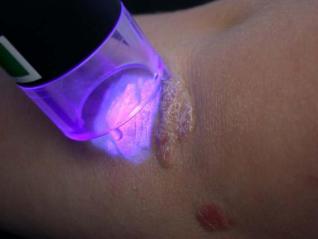
The medication can be purchase or made by the recipes of traditional medicine. The fund may not stay in the open air or under a waterproof bandage. The maximum effect in the treatment of psoriasis is a combination drug and non-pharmacological therapy. All of the tools and methods chooses a doctor.
Conclusion
As we see, the types and forms of psoriasis are very numerous, and to determine what type of illness you have, it is very difficult. Therefore, at the onset of primary symptoms should consult a physician who will determine the type of psoriasis and will prescribe the appropriate treatment. Before starting to fight against the psoriasis, faster and more efficient will be the result.
























